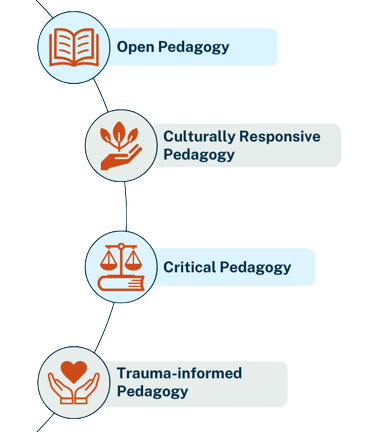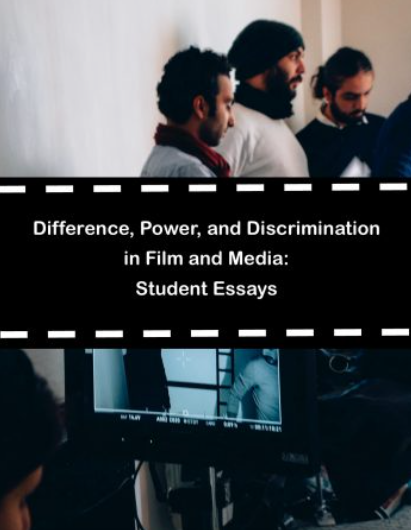3. Anti-racist and Inclusive Open Pedagogy
Chapter Subtopics
Open pedagogy and anti-racist pedagogy are ways to include underrepresented students. It includes the the teaching and learning practice and tools that empower teachers and learners to create and share knowledge openly and learn deeply. Using Anti-racist and Inclusive Open pedagogy creates a safe learning environment for students where they have agency over content creation; are not ‘othered’; and understand anti-racist pedagogy and trauma-informed practice. Always consider asking students for their input on the inclusivity of your resources, and acknowledge privilege, bias and systems of oppression.
Inclusive Open Pedagogy
Open pedagogy can be a powerful tool for letting students take control over how they engage with and relate to their course content. In some ways, engaging students in the creation of OER can be seen as the ultimate way of allowing them to see themselves reflected in their work.
However, there can be some concerns with this approach as well. For example, your student body might be composed of a majority of one race, sex, or class, making the total “picture” of the course content created by your students less inclusive overall. Here are some considerations to keep in mind when having students create course content, especially if your course is covering a topic related to sex, race, or cultural studies:
- Ask students for their input on the inclusivity of your resources.
- Think about how your OER could be more diverse (pictures, examples, etc).
- Watch out for harmful depictions of diverse populations from your students. Have a plan in place to address issues if they arise.
Fostering an environment of inclusion where your students can engage with different cultural norms is an important aspect of the college experience, whether you are teaching Physics or Criminal Justice. Although it might be daunting to jump into creating an inclusive educational resource, keep in mind that OER can be improved upon and continually revisited by yourself and others.
Start by finding or creating an OER that works for you and avoiding pitfalls like ethnocentric and trans-exclusionary language. You can always revisit your chosen OER or work with others to improve upon it by adding more diverse examples later.
Don’t “Other” Your Students
When attempting to make your course materials more inclusive for your students, the first thing you should watch out for is the possibility of “othering” your students. ‘Othering’ is the perception of a person or group as being fundamentally different from oneself or one’s own group, particularly when that person or group is seen as not only different but stigmatised and possibly threatening. Some best practices for avoiding othering include:
- Never assume your audience’s gender and/or gender identity, ability, or sexual orientation.
- Avoid calling the most commonly seen traits in your context “normal.”
- Always make materials accessible for all students.
Open Pedagogy Includes Underrepresented Students
Higher Education can adopt practices to be supportive and inclusive of the diverse population of students. We can gently (and unobtrusively) help students engage with each other and the world in the creation of OER:
- Underrepresented students can manage the OER process and content. They get to own it; they get to share it.
- Underrepresented students can portray themselves in OER. They will not represent themselves as the stereotypical “spokesperson” or as victims of exclusion and prejudice. They can and will represent themselves as central characters going about their business in their own social context.
- Students can make content decisions based on their student status. For their OER, they might want to create simplistic examples or scenarios, removed from current social issues or their own lives. (I am white; I am not going to pressure Black, Indigenous or students of Colour to use their personal experiences as material unless it is safe.)
- With encouragement, students can practice mutual aid, collaboration, and reciprocity.
- Students can have growing confidence: OER that students source and create will be relevant and “user friendly”. Students know how to write for their peers and be inclusive of them.
- Student creators can source materials from far and wide—experiences, examples, history, images, words, media, interpretations of knowledge, and other OER —beyond the classroom or the subject in question.
- Student creators don’t have to be subject to perfectionistic, imposed “ivory tower” standards for OER. OER is experimental, dynamic, responsive and imperfect. The OER will be out in the world, usable and revisable by others for their own contexts.
Aligning your Pedagogy with Equity
As you design and create your OER, there are a few considerations to think of along the way, including knowing yourself and knowing your students.
It’s key to remember that while you are creating an OER, it is merely a tool and OER-enabled pedagogy does not equal equitable pedagogy. We can still replicate harmful beliefs and practices in open education. To create positive change within the classroom and more generally in education, pedagogy needs to centre equity. But what does that look like?
In Designing for Care, the authors explain how “imagining better pedagogies is the first step in creating a powerful learning environment.” In this case, better pedagogies go beyond the delivery of course materials. It “means more humanizing pedagogies that embrace the fact that the people in our learning environments are fantastic, curious, unpredictable, capable, and multi-layered.” (Jerod Quinn; Martha Burtis; Surita Jhangiani; and Catherine J. Denial) Pedagogies that emphasise our shared humanity leave room for the cultivation of skills and knowledge for both students and educators by interrupting traditional pedagogical practices and promoting collective learning.
There are so many different types of pedagogies, some more equitable than others. Below is a short list of just a few. As you read through these, consider what you like and dislike about each one, and notice any overlaps or gaps. Think about what’s similar and what’s different to your current pedagogical approach. Are there pedagogies you haven’t considered until now?

- Open pedagogy is rooted in the belief that education should be accessible, participatory, and empowering for all learners, and that openness and collaboration are key to achieving these goals.
- Culturally-responsive Pedagogy identifies and nurtures students’ unique cultural strengths to support student success and well-being. Student learning, cultural competence, and critical consciousness are the three essential components of culturally relevant education that Dr. Gloria Ladson-Billings (1995) lists.
- Critical pedagogy is a theoretical framework that emphasizes critical thinking, social justice, and the promotion of democratic values. As such, teaching is a political act that can engage teachers and students in dialogue about existing power structures and the ways in which to address oppression in education.
- Trauma-informed Pedagogy is a method of teaching that is dedicated to understanding the various traumatic events that students may encounter and validates how these may affect their ability to learn (Imad, 2021).
Anti-Racist Pedagogy
In today’s political climate of polarization, and increasing racially motivated hate crimes, a strong movement has emerged calling for educators to do more than simply become ‘aware’, but rather to take an active anti-racist and anti-oppression stance in the classroom to mitigate prevalent social injustice.
A starting point of anti-racist pedagogy is contextualizing history and systems of oppression in course content, acknowledging privilege and bias and identifying ways to address systems of oppression.
As a great starting point familiarize yourself with some key conceptual definitions in anti-racist education. Start by completing the excellent “Basics” module created by the Calgary Anti-Racism Education.
Trauma-Informed Practice
Course content has the potential to traumatize, re-traumatize or vicariously traumatize students and needs to be introduced into the classroom using principles of trauma-informed practice. Those with their own experiences of trauma are more likely to be negatively affected, particularly if adverse events occurred in childhood. Yet, even among the latter group of students, exposure to potentially distressing content can lead to personal growth and the resolution of problems. Students can feel validated engaging with content reminiscent of their experience and develop a sense of competence. Integration of their own trauma experience through critical reflection may also help students become more informed practitioners (Zosky, 2013). The diversity of possible responses to challenging course content makes it essential that educators consider curriculum preparation and presentation and monitor student reactions.
Below are some actions educators can implement to make their course content, including OER, more trauma-informed.
- Advise students about content with clear course overviews and weekly topic outlines where possible.
- Identify the topics that will be discussed in the following class to prepare students for course progression.
- Send announcements or emails to identify upcoming topics and acknowledge increasing “intensity” in course content and progression.
- Vary the intensity of materials in each class/topic of a course or chapter in a text.
- Screen visual and aural materials before making them available to students and allow students to access educational tools in their own time, in a place of their choosing e.g. at home.
- Provide information on self-care and care for others.
- Undertake regular verbal check-ins about how students are doing emotionally.
- Demonstrate respect for limits by allowing students to make the choice to not participate.
(Griffith University, n.d).
Additionally:
- When the instruction includes sensitive content, is the material being deconstructed and situated into a historical context where warranted?
- Be aware of vicarious trauma and your own feeling when working with sensitive or distressing content.
Good Practice Example – Difference, Power, and Discrimination in Film and Media: Student Essays
 This text is an open pedagogy project of student-authored essays to help readers better understand how narrative media like movies and television represent issues of difference, power, and discrimination in American culture, both today and in the past. Through the course, students studied representations of race, ethnicity, class, gender, sexuality, and ability in American film while learning to:
This text is an open pedagogy project of student-authored essays to help readers better understand how narrative media like movies and television represent issues of difference, power, and discrimination in American culture, both today and in the past. Through the course, students studied representations of race, ethnicity, class, gender, sexuality, and ability in American film while learning to:
- Explain how difference is socially constructed;
- Use historical and contemporary examples to describe how perceived differences, combined with unequal distribution of power across economic, social, and political institutions, result in discrimination; and
- Analyze ways in which the interactions of social categories, such as race, ethnicity, social class, gender, religion, sexual orientation, disability, and age, are related to difference, power, and discrimination in the United States
The authors hope you will read and share their work to inspire frank and open-eyed conversation about issues of race, gender, class, ability, and sexuality – and how those issues are represented and misrepresented by film and television.
License and Attribution
- Enhancing Inclusion, Diversity, Equity and Accessibility (IDEA) in Open Educational Resources (OER) Copyright © 2022 by University of Southern Queensland is licensed under a Creative Commons Attribution-NonCommercial-ShareAlike 4.0 International License, except where otherwise noted.
- Open Pedagogy and the Inclusion of Marginalized Students by Deirdre Maultsaid, licensed under a CC BY 4.0 license.
- Trauma-Informed Tertiary Learning and Teaching Practice Framework [PDF] by Griffith University. Reproduced with permission.
- ‘Aligning your Pedagogy with Equity,’ in Making Ripples: A Guidebook to Challenging the Status Quo in OER Creation by Kaitlin Schilling, licensed under a CC BY 4.0 license.
- Difference, Power and Discrimination in Film and Media book cover, licensed under a CC BY-NC 4.0 license.
- some text adapted from Open Pedagogy and Practices by Mahrya Burnett, Jenay Solomon, Heather Healy, which is based on the Creative Commons’ CC Certificate Resources, Chapter 5: Creative Commons For Educators, published under a Creative Commons Attribution 4.0 International License.

